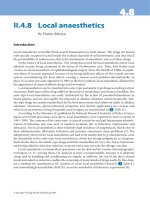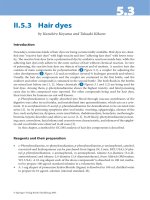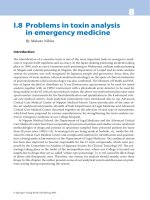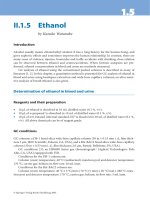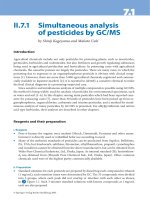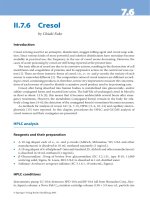Interest Rate Options - A discussion of how investors can help control interest rate exposure and make the most of the interest rate market pdf
Bạn đang xem bản rút gọn của tài liệu. Xem và tải ngay bản đầy đủ của tài liệu tại đây (236.58 KB, 46 trang )
Interest
Rate
Options
A discussion of how
investors can help
control interest rate
exposure and make
the most of the
interest rate market.
2
The Chicago Board Options Exchange
(CBOE) is the world’s largest options
marketplace and one of the largest
securities exchanges in the United
States. CBOE was founded in 1973,
creating the world’s first standard-
ized, listed equity options. CBOE’s
success has been accomplished by
leadership, innovation and its
commitment to individual and
institutional investors worldwide.
CBOE continues to push forward
with new products and new tech-
nology that help meet the needs of
the investing community.
1-877-THE-CBOE
www.cboe.com
3
Making a move
in today’s financial
markets.
Whether you invest in stocks, mutual
funds, real estate or fixed-income
instruments, there are few factors
that affect your investments more
than interest rates.
Two of the most closely watched interest rates
are the benchmark rates on short-term and long-
term U.S. Treasury securities. They reflect
changes in general economic conditions,
inflationary expectations, monetary and fiscal
policies and the value of the U.S. dollar. Other
interest rates, including bank prime lending
rates, home mortgage rates and corporate and
municipal bond rates, tend to respond to trends
in the Treasury markets.
For investors, fluctuations
in interest rates represent:
•Opportunity.
Investors can capitalize
on their outlook on these rates.
•Risk. Interest rate moves can
adversely affect the value of their
investments.
4
With CBOE Interest Rate Options, an
investor has a tool to help control interest rate
exposure and take advantage of new investment
opportunities. These options give investors the
chance to invest based upon their views on the
direction of interest rates.
What are interest rate options?
Interest Rate Options are options on the spot
yield of U.S. Treasury securities. Available to
meet the investor’s needs are options on short-,
medium- and long-term rates. The following
contracts are available for trading at the Chicago
Board Options Exchange:
• Options on the short-term rate (ticker
symbol IRX) are based on the annualized
discount rate on the most recently auc-
tioned 13-week Treasury bill. The 13-week
T-bill yield is the recognized benchmark of
short-term interest rates. These bills are issued
by the U.S. Treasury in auctions conducted
weekly by the Federal Reserve Bank.
• Options on the 5-year rate (ticker symbol
FVX) are based on the yield-to-maturity of
the most recently auctioned 5-year Treasury
note. The notes are usually auctioned every
month.
• Options on the 10-year rate (ticker symbol
TNX) are based on the yield-to-maturity of
the most recently auctioned 10-year Trea-
sury note. The notes are usually auctioned
5
every three months following the refunding
cycle: February, May, August and November.
• Options on the 30-year rate (ticker symbol
TYX) are based on the yield-to-maturity of
the most recently auctioned 30-year Trea-
sury bond. Treasury bonds are auctioned
every six months in a February and August
refunding cycle.
IRX, FVX, TNX, and TYX values are reported
throughout the trading day by Telerate Systems
Incorporated, a leading international supplier of
financial services. These values are based on
current market data from the Treasury securities
markets. Options prices, on the other hand, are
disseminated by CBOE. Both these values and
option prices are available through most on-line
pricing services.
How do interest rate options work?
Options on interest rates and listed stock and
stock index options have similar benefits and
risks. They are standardized contracts traded on
an exchange regulated by the Securities and
Exchange Commission. There are two types of
contracts: puts and calls.
In general, when yield-based option positions are
purchased, a call buyer and a put buyer have
opposite expectations about interest rate move-
ments. A call buyer anticipates interest rates will
go up, increasing the value of the call position. A
put buyer anticipates that rates will go down,
increasing the value of the put position.
6
A yield-based call option holder will profit if,
by expiration, the underlying interest rate rises
above the strike price plus the premium paid
for the call.
Conversely, a yield-based put option holder will
profit if, by expiration, the interest rate has
declined below the strike price less the premium.
Option writers (sellers) receive a premium for
selling options to buyers. Sellers tend to view
premiums received for selling options as a source
of additional income or as a hedge against a
possible decline in the value of treasuries they
hold or intend to purchase.
Yield-based options can be used alone or in
conjunction with the underlying securities. The
economics of the two approaches may be quite
different. Prospective investors should consult
their financial advisor about the logistics and
suitability of their approach.
The Options’ Underlying Values
Underlying values for the option contracts are
10 times the underlying Treasury yields (rates)—
13-week T-bill yield (for IRX), 5-year T-note
yield (for FVX), 10-year T-note yield (for TNX)
and 30-year T-bond yield (for TYX). An
annualized discount rate of 5.5% on the newly
auctioned 13-week Treasury bills would place the
underlying value for the option on short-term
rates (IRX) at 55.00. A yield-to-maturity of 6%
7
Cash settled. Interest Rate Options
are settled in cash. There is no need
to own or deliver any Treasury
securities upon exercise.
Contract size. Interest Rate Options
use the same $100 multiplier as
options on equities and stock
indexes.
European-style exercise. The holder
of the option can exercise the right
to buy or sell only at expiration. This
eliminates the risk of early exercise
and simplifies investment decisions.
on the 30-year T-bond would place the
underlying value of the yield-based option on
the 30-year T-bond (TYX) at 60.00.
When Treasury rates change, corresponding
underlying values for the options on interest
rates also change. For example, if the yield-to-
maturity on the 30-year T-bond increases from
6.25% to 6.36%, TYX would move from 62.50
to 63.60. For every one percentage point rise or
fall in interest rates, underlying values would rise
or fall 10 points.
Interest Rate Options features:
8
Comparing Interest Rate Options to
other options.
A main difference between Interest Rate Options
and listed equity options is that the underlying
values of Interest Rate Options are based on
interest rates and not on units of specific
Treasury bills, notes or bonds. Individual equity
options’ underlying securities are shares of a
specific stock.
Prices on Treasury obligations, like prices on all
fixed-income securities, are inversely related to
interest rates. An investor must be able to
understand this inverse relationship between
bond prices and yields. That is, whenever interest
rates rise, prices on outstanding Treasury
securities fall. Whenever interest rates decline,
prices on outstanding Treasury securities rise.
To see why prices must fall when interest rates
rise, consider a Treasury bond held by an
investor with a principal or par amount of
$1,000, payable at maturity, and a coupon
interest rate of 7%. This means that the bond
pays $70 a year in interest until maturity, when
the principal amount of $1,000 is paid to
the holder. These terms will not change over the
life of the bond. Like a stock, this bond has a
value for which it can be sold in the market.
That value reflects the rate at which the market-
place discounts this bond’s payment stream.
9
If interest rates rise, the amount that would be
necessary to invest to receive $70 per year would
drop. (If, for example, rates rise to 10%, the
necessary investment would be only $700.) The
fact that a smaller investment is required to
receive the same payment stream explains why
bond values fall as long-term rates rise. But the
converse is also true. As long-term rates fall a
larger investment is required to receive the same
payment.
There are formulas or algorithms that allow
investors to find bond prices given knowledge of
their yields or their yields given knowledge of
their prices. The actual calculations, however, are
complex. Desired numbers can be found using
specialized calculators and bond tables. They
may also be available from your financial
advisor.
Cash Settlement.
Since Interest Rate Options are cash-settled,
exercise of a put or call gives the holder the cash
difference between the exercise price and the
exercise-settlement value, times the $100
multiplier. The exercise-settlement value is based
on the spot-yield, as reported by Gov Px.
For example, an investor holding an expiring
TYX “in-the-money” (ITM) July 75 call option
with an exercise-settlement value of 78 would
10
exercise the option and receive the cash
difference of $300 [(78 - 75) x $100]. An
option is ITM if the underlying security is
higher (lower) than the strike price of the call
(put).
78 (exercise-settlement value)
-75 (strike price)
3 x $100 multiplier = $300
For example, if the exercise-settlement value is
below the strike price of an expiring call, or
above the strike price of an expiring put, the
option simply expires “out-of-the-money”
(OTM) and will be worthless. If the exercise-
settlement value turned out to be at or below the
75 strike price at the July expiration, the TYX
July 75 call option would be worthless.
Of course, an investor does not have to wait
until expiration to close an option position. A
closing transaction could be executed at anytime
prior to expiration. For instance, an opening
purchase of the TYX July 75 call option could be
closed out by selling the same TYX July 75 call
option at anytime prior to the July expiration.
The profit (or loss) in the position would be the
difference between the premium originally paid
when the option was purchased and the pre-
mium received upon the sale of the option.
11
Interest Rate Movement
and Option Premium.
Interest Rate Options in many ways are like all
other traded options. They are affected by
similar factors: e.g., volatility, time to expiration,
and the price level of the under-lying instru-
ment. Nonetheless, there are certain consider-
ations regarding the structure of interest rates
and the very nature of the underlying instru-
ment itself that investors must take into account
to fully understand the behavior of interest rate
options and their differences from other traded
options.
Since these options will settle at a future
expiration date, investors must form expecta-
tions about the yield on the underlying instru-
ment. The yield that the market expects to
prevail at expiration is called the forward yield
or forward rate.
These yield-based options are European-style
and, therefore, cannot be exercised until
expiration. For this reason, the options will be
priced off the market’s best estimate of the
yield of the underlying instruments at
expiration of the options; or, in other words,
the market’s best estimate of the exercise-
settlement value at expiration, that is, off the
forward rates. If the market is currently
projecting a forward rate that is below the
current spot rate, call options will fall in value
and put options will rise in value.
12
The forward pricing phenomenon may be
apparent only at the short-end of the yield
curve.
The difference between the current spot yield
and the forward yield can be significant, even
for short-dated options. In general, it will
depend on the segment of the U.S. Treasury
yield curve considered. In the U.S., the yield
curve has been upward-sloping (normal) during
most of modern U.S. financial history, meaning
that long-term Treasuries have a higher yield
than short-term. A downward-sloping (inverted)
or flat yield curve illustrates short-term Treasur-
ies with a higher yield than long-term. The
curve has also been steeper at the short end with
a tendency to flatten out at longer maturities. A
consequence of this type of yield curve is that
the shorter the maturity of the Treasury securi-
ties, the greater the divergence between current
spot and forward yields. There is likely to be less
difference between the yield of a Treasury bond
with 30 years to maturity and the yield of a
Treasury bond with 29-3/4 years to maturity
than there is between the yield of a 13-week
T-Bill with 3 months to maturity and the
yield of a 13-week T-Bill with one month to
maturity.
Tracking Forward Rates.
Again, call options have intrinsic value when
the current underlying value is greater than
the exercise price. Put options have intrinsic
value when the current underlying value is
13
lower than the exercise price. A result of
options tracking forward rates rather than
current spot rates is that when rates are
projected to fall, call options can trade below
intrinsic value relative to the current spot
yield. In other words, trading at a discount
from parity can occur.
The time value of an option is that part of the
premium that reflects the remaining life of the
option. The more time that remains before the
expiration date, the higher the premium,
because there is more time available for the
underlying value to move up or down. Another
result of forward pricing is that premiums may
be lower in the later months than in nearby
months when the market is forecasting a lower
forward rate in the far month than in the nearby
month. If the difference in forward rates is large
enough to offset the time value associated with
the longer expiration, then the premium on the
longer expiration could be below the premium
on the nearby month with the same strike price.
The same but reverse phenomenon appears in
puts when the market is projecting higher
forward rates relative to current interest rates.
The time premium in the far out months
may be less than the near-term months due to
the market projecting a higher forward rate in
the far month than in the nearby month.
Also, if the market revises its estimate of
forward rates, option prices may move sharply
when current spot rates are unchanged.
14
Basic Strategies
with
Interest Rate
Options
Using options to implement interest
rate strategies offers several advan-
tages to transactions in Treasury
securities:
Option buying involves a known and limited
risk. Like any option, the most an option buyer
can lose if interest rates move against him is the
premium paid for the option. Unlike a Treasury
security, however, an option can expire worth-
less. Option selling involves limited profit and
unlimited risk. Like any option, the most a seller
can make is the premium received and the risk
theoretically is unlimited if interest rates move
against him.
Options provide leverage. An option buyer
pays a relatively small premium in relation to
the value of the underlying security. If interest
rates move as anticipated, substantial profits
relative to the capital invested may be realized.
If the interest rates do not move as anticipated,
the buyer’s risk is limited to the premium
paid. Also, small moves in interest rates can
have a large impact on the value of the options
position.
15
Options involve a specific time period. An
option buyer can choose an expiration month
which meets his time expectations for interest
rates moves. Treasury securities do not have to
move immediately for a buyer to profit on his
option position. However, a move in the
anticipated direction must occur by option
expiration in order for the option position to
become profitable.
In the following examples, we present a variety
of possible option strategies for different interest
rate forecasts. These are only a few of the
strategies that might be employed. There are
numerous other strategies, some more sophisti-
cated than others, that may be used by investors
who are experienced and understand how they
work and when to use them. The examples
discussed below are based on hypothetical
situations, should only be considered samples of
potential investment alternatives, and are
presented for educational purposes only.
The positions are shown being held to expira-
tion. It should also be noted that taxes,
commissions and margin requirements have
not been included in the following examples
to simplify the explanations. They are impor-
tant and must be taken into account when
considering an actual trade, and when calcu-
lating actual net returns on any option
transaction. These charges and requirements
may vary, and should be discussed with your
investment advisor.
16
Scenario 1:
Investor expects rising
long-term interest rates.
Forecast: Rising 30-year Treasury bond yields.
Objective: To profit from rising 30-year interest
rates.
If an investor anticipates a rise in the 30-year
Treasury bond yield, he might choose to buy TYX
call options. If the anticipated rate increase occurs,
TYX, the 30-year underlying value for the options
(10 x 30-year yield), also will increase.
This strategy gives the buyer the right to a payoff
equal to the difference between the strike price and
exercise-settlement value of TYX upon option
expiration if the underlying value rises above the
strike price. The profit is unlimited, while the risk
is limited to the premium paid for the calls.
Example:
TYX is at 70.00 (the 30-year interest rate at
7.00%) and a three-month TYX 70 at-the-
money call is trading at 1.50. For this
example, the investor who expects 30-year
Treasury yields to rise will buy 5 calls at a cost
of $750 (1.50 premium x $100 multiplier x 5
Buy TYX calls.
1
17
contracts). A profit will be realized if the
underlying rises above the breakeven of 71.50
(70 strike price + 1.50 premium) which
translates into a current yield of 7.15%
(1/10th of the underlying value) on the 30-year
Treasury.
Possible Outcomes
Outcome 1:
Exercise-settlement Value Above
Breakeven (71.50).
If the 30-year Treasury bond yield rises and the
exercise-settlement value for TYX is at 75.00 at
expiration (interest rates at 7.5%), the TYX 70
call option would be exercised, the holder of the
calls would receive the amount by which the
closing yield exceeds the strike price.
Exercise-settlement Value: 75
Less Strike Price:
70
5
Amount Paid to Holder: $2,500
(5 x $100 x 5 contracts )
Less Cost of Calls:
-750
Profit: $1,750
This investor profited because the yield did
rise above the breakeven prior to expiration.
Had the yield on the 30-year Treasury risen
after expiration the options would have
expired worthless. This timing consideration
applies to all of the strategies discussed below.
18
Outcome 2:
Exercise-settlement Value Between
Call Strike Price (70) and Breakeven
Level (71.50).
If, by expiration, the 30-year Treasury yield
slightly increases to 7.10% which equals an
exercise-settlement value of 71.00, the holder
would exercise his options. He would receive
the amount by which the exercise-settlement
value is above the strike price. The amount
received would be less than what was origi-
nally paid, but it would offset some of the cost
of the calls.
Exercise-settlement Value: 71
Less Strike Price:
70
1
Cost of Calls: $750
Less Amount Paid to Holder:
-500
(1 x $100 x 5 contracts )
Loss: $250
Outcome 3:
Exercise-settlement Value At or Below
Call Strike Price (70).
If the exercise-settlement value is at or below 70.00
(the yield on the 30-year Treasury at or below
7.00%), the holder would have lost the total
premium of $750, in this example. However,
no matter how low interest rates decline the
most that can be lost is the premium paid.
19
Importantly, if the yield on the Treasury rises
substantially and/or the investor’s opinion
changes, the calls may be sold at any point in
time through the last trading day of that
particular series.
Forecast: Investor expects moderate rise
in 30-year Treasury bond yields.
Objective: To profit from an increase
in rates by bringing in income.
If a rise in the 30-year Treasury bond yield is
expected, an investor may choose to sell a TYX put
spread to increase income. Selling a put spread
involves selling a put and buying a put with a
lower strike price, both with the same expiration.
The purpose in selling the put spread is to limit risk
while receiving premium. The most that can be lost
is the difference between the two strike prices less
the premium received and the most that can be
made is the premium received for selling the
spread. If the investor simply sold puts outright he
would have received more premium but with
significant risk.
Example:
Assume, as before, that TYX is still at 70.00,
and a rise in 30-year interest rates from
7.00% to 7.5% is anticipated in the next
three months. For simplicity’s sake the
Sell TYX put spread.
2
20
investor will sell 1 three-month TYX 75 put
and purchase 1 three-month 70 put. The
premium received for this spread position is:
Sell 1 Three-month 75 Put
at 4.75 x 100 = $475.00*
Buy 1 Three-month 70 Put
at 1.25 x 100 = -
125.00
Total Premium Received = $350.00
* These puts are trading at a discount to parity
due to the European-style exercise (the
options cannot be exercised until expiration).
The total premium received is the maximum
profit that can be made. The maximum risk is
the difference between the strikes less the
premium received.
Short Strike: 75
Long Strike:
-70
5
Premium Received:
-3.50
Maximum Risk: 1.50
The risk for this position is 1.50 x 100 or
$150.00. The breakeven on this position is
71.50. The breakeven is calculated by sub-
tracting the premium received, 3.50 from the
short 75 strike price.
21
Possible Outcomes
Outcome 1:
Exercise-settlement Value At or
Above Short Put Strike Price (75).
If 30-year the Treasury bond yield rises and the
exercise-settlement value for TYX is at 76.00 at
expiration (interest rates at 7.60%), the TYX 70
put and the 75 put both expire worthless and
the investor keeps the total premium received,
$350.00. This is the maximum profit that could
be earned. This would be the result for any TYX
exercise-settlement value at or above 75.
Outcome 1:
Exercise-settlement Value Between
Short Put Strike Price (75) and
Breakeven (71.50).
If, by expiration, the 30-year Treasury yields do
increase to 7.45 which equals an exercise-
settlement value of 74.5, the spread seller would
be assigned on his short put position and his
long position would expire worthless. He would
deliver the amount by which the exercise-
settlement value is below the strike price. The
seller of the spread would give up some of the
premium received but not all of it.
Short Strike Price: 75
Less Exercise-settlement Value: -
74.5
Amount to Deliver: .5
Amount Rec’d for Selling Spread: $350.00
Less Amount to Deliver:
-50.00
(0.5 x $100 x 1 contract)
Profit: $300.00
22
Outcome 2:
Exercise-settlement Value Between
Long Put Strike Price (70) and
Breakeven (71.50).
If, at expiration, the yield on the TYX is
7.05% (the exercise-settlement value is 70.5),
the spread seller would be assigned on the
short side. The seller would have to give back
some of the premium received.
Short Strike Price: 75
Less Exercise-settlement Value:
-70.5
Amount to Deliver: 4.5
Amount to Deliver: $450.00
(4.5 x $100 x 1 put)
Less Original Premium Received:
-350.00
Loss: $100.00
Outcome 3:
Exercise-settlement Value At or
Below Long Put Strike Price (70).
If the exercise-settlement value is at 67.5 (the
yield on the 30-year Treasury is at 6.75%),
the spread seller would have lost 1.50, the
difference between the strikes (5) less the
premium received for selling the spread
(3.50). However, no matter how low interest
rates decline, the most that can be lost is
$150.00, the difference between the strikes
less the premium received.
Short Strike Price: 75
Less Exercise-settlement Value:
-67.5
Amount to Deliver: 7.5
23
Long Strike Price: 70
Less Exercise-settlement Value:
-67.5
Amount Received: 2.5
Amount Delivered: 7.5
Less Amount Received:
-2.5
Net Delivered: 5
The spread seller would pay out $750 (7.5 x $100
x 1 put) for the assignment of his short put and
would receive $250 (2.5 x $100 x 1 put) for
exercising his long put for a net cost of $500.
Net Delivered (See Above): $500.00
Less Original Premium Received: -
350.00
Maximum Loss: $150.00
As the exercise-settlement value declines below 70
the amount to be delivered will increase but so
will the amount paid to the investor. The net
amount will always be $500, the difference
between the two strikes. Therefore, the risk is
limited to $150.00, the difference between the
strikes less the premium received for selling the
put spread.
24
Scenario 2:
Falling 5-Year Interest
Rates.
Forecast: Falling 5-year Treasury note yields.
Objective: To profit from a decline in 5-year
interest rates.
Assume that a decline in 5-year Treasury note rates
is expected in the next few months. An investor
would like to have the opportunity to profit if this
forecast is correct. A purchase of FVX put options
would allow the holder to profit if rates do decline
because as 5-year interest rates fall, so does the
level of FVX.
As interest rates decline and the level of the 5-year
underlying declines, the value of the put options
should increase. An investor might be able to sell
the put options at a profit, thereby closing out the
position. Or, he can hold the put options for the
profit potential they have upon exercise at expira-
tion.
Example:
If the underlying 5-year interest rate is 6.50%,
the level of FVX would be 65. An investor
anticipates a decline of roughly 30 basis points
Buy FVX puts.
1
25
in 5-year interest rates to somewhere close to
6.2% (FVX at 62). He decides to buy 10
two-month FVX 65 (at-the-money) put
options at $750.00 (.75 premium x $100
multiplier x 10 puts). This sum will be the
maximum loss if the forecast is wrong, and 5-
year Treasury rates increase. The breakeven for
the put position is 64.25, (65 strike price -
.75 put premium).
Possible Outcomes
Outcome 1:
Exercise-settlement Value Below
Breakeven (63).
If 5-year Treasury note yields do decline and
the exercise-settlement value for FVX is at
63.00 at expiration (interest rates at 6.3%),
the FVX 65 put option would be exercised
and the holder of the puts would receive the
amount by which the closing yield has
declined below the strike price.
Strike Price: 65
Less Exercise-settlement Value:
-63
2
Amount Received: $2,000
(2 x $100 x 10 contracts )
Less Cost of Puts:
-750
Profit: $1,250

